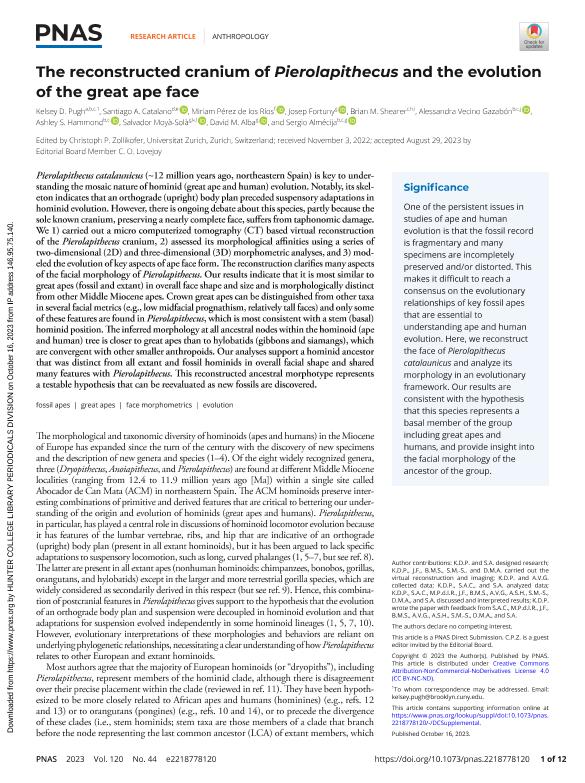Artículo
The reconstructed cranium of Pierolapithecus and the evolution of the great ape face
Pugh, Kelsey D.; Catalano, Santiago Andres ; Pérez de los Ríos, Miriam; Fortuny, Josep; Shearer, Brian M.; Vecino Gazabón, Alessandra; Hammond, Ashley S.; Moyà Solà, Salvador; Alba, David M.; Almécija, Sergio
; Pérez de los Ríos, Miriam; Fortuny, Josep; Shearer, Brian M.; Vecino Gazabón, Alessandra; Hammond, Ashley S.; Moyà Solà, Salvador; Alba, David M.; Almécija, Sergio
 ; Pérez de los Ríos, Miriam; Fortuny, Josep; Shearer, Brian M.; Vecino Gazabón, Alessandra; Hammond, Ashley S.; Moyà Solà, Salvador; Alba, David M.; Almécija, Sergio
; Pérez de los Ríos, Miriam; Fortuny, Josep; Shearer, Brian M.; Vecino Gazabón, Alessandra; Hammond, Ashley S.; Moyà Solà, Salvador; Alba, David M.; Almécija, Sergio
Fecha de publicación:
10/2023
Editorial:
National Academy of Sciences
Revista:
Proceedings of the National Academy of Sciences of The United States of America
ISSN:
0027-8424
Idioma:
Inglés
Tipo de recurso:
Artículo publicado
Clasificación temática:
Resumen
Pierolapithecus catalaunicus (~12 million years ago, northeastern Spain) is key to understanding the mosaic nature of hominid (great ape and human) evolution. Notably, its skeleton indicates that an orthograde (upright) body plan preceded suspensory adaptations in hominid evolution. However, there is ongoing debate about this species, partly because the sole known cranium, preserving a nearly complete face, suffers from taphonomic damage. We 1) carried out a micro computerized tomography (CT) based virtual reconstruction of the Pierolapithecus cranium, 2) assessed its morphological affinities using a series of two-dimensional (2D) and three-dimensional (3D) morphometric analyses, and 3) modeled the evolution of key aspects of ape face form. The reconstruction clarifies many aspects of the facial morphology of Pierolapithecus. Our results indicate that it is most similar to great apes (fossil and extant) in overall face shape and size and is morphologically distinct from other Middle Miocene apes. Crown great apes can be distinguished from other taxa in several facial metrics (e.g., low midfacial prognathism, relatively tall faces) and only some of these features are found in Pierolapithecus, which is most consistent with a stem (basal) hominid position. The inferred morphology at all ancestral nodes within the hominoid (ape and human) tree is closer to great apes than to hylobatids (gibbons and siamangs), which are convergent with other smaller anthropoids. Our analyses support a hominid ancestor that was distinct from all extant and fossil hominids in overall facial shape and shared many features with Pierolapithecus. This reconstructed ancestral morphotype represents a testable hypothesis that can be reevaluated as new fossils are discovered.
Palabras clave:
PIEROLAPITHECUS
,
3D MODELS
,
APE FOSSILS
,
SKULL
Archivos asociados
Licencia
Identificadores
Colecciones
Articulos(UEL)
Articulos de UNIDAD EJECUTORA LILLO
Articulos de UNIDAD EJECUTORA LILLO
Citación
Pugh, Kelsey D.; Catalano, Santiago Andres; Pérez de los Ríos, Miriam; Fortuny, Josep; Shearer, Brian M.; et al.; The reconstructed cranium of Pierolapithecus and the evolution of the great ape face; National Academy of Sciences; Proceedings of the National Academy of Sciences of The United States of America; 120; 44; 10-2023; 1-12
Compartir
Altmétricas



